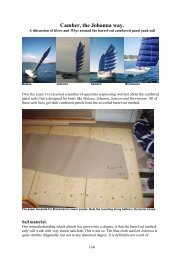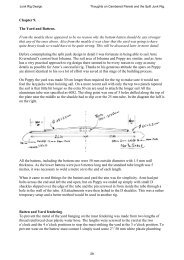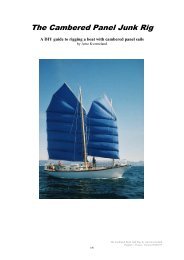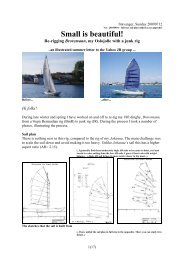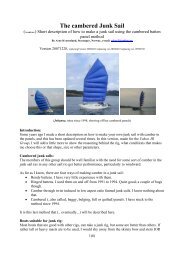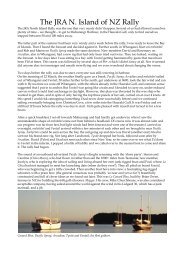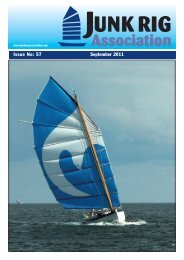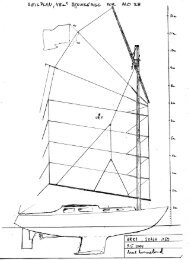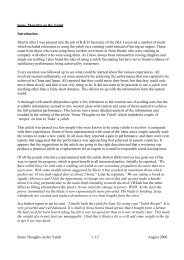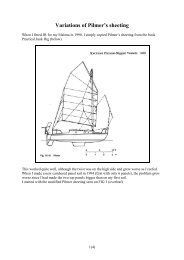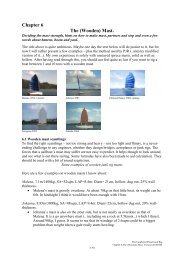Download - The Junk Rig Association
Download - The Junk Rig Association
Download - The Junk Rig Association
You also want an ePaper? Increase the reach of your titles
YUMPU automatically turns print PDFs into web optimized ePapers that Google loves.
<strong>The</strong> <strong>Junk</strong> <strong>Rig</strong><br />
(the westernised version, as developed by<br />
Blondie Hasler in the UK, and by Tom<br />
Colvin in the US)<br />
<strong>The</strong> two pioneers who did most<br />
to bring the junk rig to the<br />
attention of the sailing public.<br />
Blondie sailed “Jester” in the<br />
first single-handed<br />
transatlantic race, and Tom has<br />
designed a range of functional<br />
junk rigged yachts and cargo<br />
vessels.<br />
1
One of the best known<br />
of junk rigged boats,<br />
thanks to Annie Hill’s<br />
book “Voyaging on a<br />
small income”<br />
She has sailed more than<br />
100,000 miles in the North<br />
and South Atlantic, from<br />
Greenland to the South<br />
Orkney Islands. She is one<br />
of Jay Benford’s sailing<br />
dory designs. Everything<br />
was home-made, on a very<br />
limited budget<br />
“Badger”,in Greenland<br />
2
What is it<br />
A rig derived from the rigs used in China, and adapted for use<br />
on modern yachts<br />
It may have a stayed or un-stayed mast(s), but an unstayed mast<br />
is usually preferred<br />
It always has stiff battens, most of which are controlled by a<br />
sheeting system which permits control over reefing and sail<br />
shape.<br />
Stresses are widely distributed, and are much lower than in the<br />
bermudan rig<br />
It usually has a yard at an angle of between 20 and 70 degrees<br />
to the horizontal<br />
3
What does it do<br />
well<br />
Reefing (on any point of<br />
sail) is a simple matter of<br />
easing the halyard and<br />
trimming the sheet and the<br />
other control lines<br />
15 seconds for<br />
the first reef<br />
Furling (on any point of<br />
sail) is a simple matter of<br />
letting go the halyard,<br />
when the sail is gathered<br />
into the topping lifts<br />
Failsafe<br />
Tacking is a simple matter<br />
of putting the helm over -<br />
no sheets to handle<br />
No flogging<br />
Gybing is easy, quiet and<br />
safe<br />
No dramas<br />
When the sheet is eased,<br />
the sail is quiet and<br />
docile<br />
No flogging<br />
Speed can easily be<br />
controlled by easing sheets<br />
and/or reefing, when<br />
approaching harbour<br />
Performance downwind is<br />
superior to bermudan rig<br />
No dramas, again<br />
Less heeling, easier motion<br />
4
What does it do<br />
badly<br />
A flat junk sail does<br />
not have the drive<br />
of a cambered sail,<br />
and performance to<br />
windward in light<br />
breezes is poor, when<br />
compared to that of a<br />
bermudan boat with a<br />
genoa<br />
Nothing else<br />
So why doesn’t the<br />
modern yachtsman use<br />
the junk rig, when he<br />
seems to prefer motoring<br />
to windward Innate<br />
conservatism, and an<br />
unwillingness to stand out<br />
from the crowd, perhaps<br />
5
How can the windward<br />
performance be improved<br />
By adding camber -<br />
obvious, really<br />
In strong and variable<br />
winds, a junk rigged<br />
yacht can make safely<br />
and comfortably to<br />
windward when a<br />
bermudan rigged yacht is<br />
finding the going too<br />
difficult<br />
6
<strong>The</strong> fiendishly-clever<br />
Chinese way of adding<br />
camber, that Blondie<br />
Hasler somewhat<br />
overlooked when he<br />
designed his rigs<br />
A fanned sail develops camber in its<br />
upper part by twisting, even if it is<br />
cut flat<br />
7
Hinges have been used<br />
successfully, but most<br />
ocean sailors don’t<br />
favour them<br />
Hinged battens have been used, but<br />
integrity is compromised, and the<br />
standard of design and manufacture must<br />
be high<br />
8
<strong>The</strong> preferred approach is to build camber into most of<br />
the panels of the sail, using a variety of sailmaking<br />
techniques - broad seam, shelf foot, tucks etc<br />
9
“Tystie” has covered<br />
nearly 50,000 miles<br />
with these sails.<br />
<strong>The</strong> first (GRP,) battens<br />
were replaced a year ago,<br />
in New Zealand, with<br />
lighter, better shaped<br />
ones in aluminium alloy<br />
Best, but at a high cost, is the “soft<br />
wing-sail”, enclosing the mast. <strong>The</strong> after<br />
part of the sail has stiff battens, but the<br />
forward part is doubled around wishbones,<br />
enclosing the mast<br />
10
<strong>The</strong>re are many different<br />
planforms and varieties<br />
of junk rig<br />
From left to right:<br />
1.A Wharram catamaran with a wing sail<br />
on each hull<br />
2.A “split rig”, with cambered “jibs”<br />
and mainsail<br />
3.A commercially available sail shape<br />
11
“China Moon”, in<br />
the Tamar River<br />
<strong>Junk</strong> rig on a catamaran- one mast in<br />
each hull<br />
12
Aren’t all the control<br />
lines very complicated<br />
Not as complicated as those<br />
in a bermudan rig - just<br />
different<br />
A halyard, usually with<br />
several parts because the<br />
sail bundle is heavier<br />
A sheet, which also acts as<br />
reefing lines<br />
A yard parrel keeps the yard<br />
close to the mast<br />
A luff parrel peaks up the<br />
yard and shapes the sail<br />
Batten parrels keep the<br />
battens close to the mast<br />
Topping lifts support the<br />
aft end of the sail bundle<br />
Another lift supports the<br />
forward end of the sail<br />
bundle<br />
<strong>The</strong>re may be more luff<br />
parrels<br />
<strong>The</strong>re may be batten<br />
downhauls<br />
13
A fanned<br />
sail<br />
One of the modern sail<br />
shapes, with the major<br />
lines shown<br />
A Raven 26’ , “Fantail”,<br />
now being rigged in New<br />
Zealand<br />
14
Is an un-stayed mast<br />
safe<br />
Safer than a stayed<br />
mast<br />
If it is designed<br />
right, and built<br />
right, it is very<br />
difficult to get an<br />
un-stayed mast to<br />
fail<br />
It takes a load in excess<br />
of that for which the<br />
rig was designed - a 360<br />
degree rollover will do it<br />
A stayed mast relies<br />
on every component of<br />
its complex<br />
triangulated staying<br />
system being in place<br />
- if one little pin<br />
is lost, the whole<br />
rig might be lost<br />
Stays often fail<br />
through fatigue<br />
15
Isn’t an unstayed<br />
mast very heavy<br />
<strong>The</strong> un-stayed mast<br />
itself is heavier<br />
than a bermudan<br />
mast, because it<br />
must be designed to<br />
resist bending loads<br />
<strong>The</strong> bermudan mast is<br />
lighter, because it<br />
only has to resist<br />
compressive loads<br />
However, when the<br />
weight of all the<br />
standing rigging is<br />
added to the weight<br />
of a bermudan mast,<br />
the un-stayed mast<br />
usually shows a<br />
weight saving<br />
16
Can I make a junk<br />
rig for my boat<br />
<strong>The</strong>re is nothing that<br />
a backyard handyman<br />
cannot make - unlike<br />
bermudan rig<br />
Spars can be of wood<br />
or aluminium alloy<br />
tube<br />
If you made it, you<br />
can also mend it in<br />
remote places<br />
Sails can be made<br />
from polyester<br />
sailcloth, but since<br />
the stresses are<br />
lower than in<br />
bermudan rig, a wider<br />
range of fabrics is<br />
suitable - making<br />
home sailmaking<br />
easier<br />
Try a dinghy rig<br />
first<br />
17
Where can I find out<br />
more<br />
<strong>The</strong> standard book is<br />
“Practical <strong>Junk</strong> <strong>Rig</strong>”,<br />
by Blondie Hasler &<br />
Jock McCleod. We have<br />
made advances in<br />
several areas since<br />
it was published in<br />
1988, but up to the<br />
stage of development<br />
that they reached, it<br />
cannot be faulted. It<br />
is an essential<br />
reference when<br />
designing and<br />
building a junk rig<br />
<strong>The</strong> <strong>Junk</strong> <strong>Rig</strong><br />
<strong>Association</strong> has a<br />
website at<br />
www.junkrigassociation.org<br />
with a great deal of<br />
useful knowledge, and<br />
fora to talk with<br />
fellow enthusiasts<br />
18



